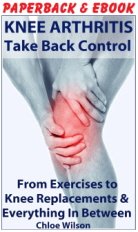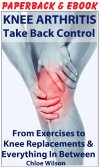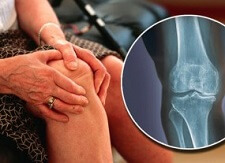Partial Knee Replacements
Written By: Chloe Wilson, BSc(Hons) Physiotherapy
Reviewed by: KPE Medical Review Board

Partial Knee Replacements are where one side or the knee joint is removed, usually due to wear and tear on the cartilage and bone from arthritis, and replaced with a prosthesis.
Also known as a PKR or unicompartmental knee replacement, it is a smaller operation than a total knee replacement which leads to a quicker recovery time.
Uni-knees also have the advantage that the knee ligaments remain intact rather than being removed, allowing greater function.
People often have lots of questions about partial knee replacements (PKR) both before and after having surgery.
Here you will find answers to the most commonly asked ones. If you want to know more about knee replacement surgery, visit the PKR overview.
Frequently Asked Questions About Partial Knee Replacements
1. How Common Are Partial Knee Replacements?
Approximately 8-15% of knee replacements performed are partial ones. That is about 8,000 per year in the UK and 13,000 in the US.
2. How Is A PKR Different to a TKR?
A total knee replacement involves removing and replacing both sides of the knee joint as well as the cruciate ligaments.
With partial knee replacements, only one side of the knee joint is replaced and all the ligaments remain intact.
3. What Type Should I Have?
If your arthritis is confined to one side of the knee joint, then you should be able to have a partial knee replacement. If both sides are affected by arthritis, you will need to have a total knee replacement.
4. What Happens During Surgery?
With partial knee replacements, the arthritic side of the knee joint is removed (tibia and femur) and replaced with a prosthesis made from metal and plastic. The knee ligaments are left intact.
5. When Can I Get Up & About?
Your physical therapist will help you get up either the day of your surgery or the following day. In most cases, you can take as much weight through your new knee as feels comfortable - you may need to use a walking frame, crutches or sticks initially.
6. When Can I Shower?
You must wait until the wound is completely dry (not oozing) before showering after knee replacement surgery, which is usually about 5 days.
7. When Can I Return to Work?
For sedentary jobs, people usually return to work 2-4 weeks after partial knee replacements. For physically demanding jobs, you will need to wait approximately 2-3 months.
8. What Activities Can I Do?
You can generally, in time, get back to any activity following partial knee surgery. Start off slowly and gradually increase how much you can do being guided by your knee.
9. How Long Do I Need To Exercise For?
You will start exercises almost immediately after your knee replacement surgery. It even helps to start them beforehand so your muscles are in the best condition possible.

It is really important to continue your exercises until
you have regained full range of movement of your knee (can fully bend
and straighten it) and good strength in the muscles.
Even when you have
achieved this, it is worth continuing with your exercises 2-3 times
weekly indefinitely to keep your new knee in its best condition. See
the
Knee Replacement Exercise
section for more information.
10. How Do I know If I’m Overdoing It?
A bit of
discomfort when doing something after a partial knee replacement doesn’t mean you need to stop. It
should however settle within about half an hour.
If pain continues for more than two hours after stopping the activity, that is a sign you have overdone it.
Next time, reduce the intensity or time you do the activity for. If an
activity causes immediate severe pain, do stop straight away.
11. How Long Do Partial Knee Replacements Last?
PKR's are lasting longer and longer - 98% last at least ten years, 92% at least twenty years.
12. What Happens If The Prosthesis Fails?
Occasionally something goes wrong with partial knee replacements. Sometimes they can be redone (known as a revision) but in most cases the prosthesis would be removed and converted to a total knee replacement.
Check Out Our Book
All the info you need about knee arthritis, top tips, exercises & loads more.
Rated 4.4/5
Find Out More
13. When Can I Have Sex?
It is usually best to wait for 4-6 weeks.
14. Can I Still Play Golf?
Yes, typically after 4-6 weeks, depending on how the knee feels.
15. What About Metal Detectors?
Knee replacements do not normally set off metal detectors e.g. at an airport, but if they do, security may want to see your scar as proof of your operation.
16. Will My Knee Hurt?
It is entirely normal to experience some pain after a knee replacement for a few weeks as the skin, muscles and bone have been cut and take time to heal. This normally settles down within a few weeks. Many people actually find they have less pain after surgery than before, as they are no longer getting arthritis pain.
More On Partial Knee Replacements
To find out more about partial knee replacements, choose from the following links.
- Partial Knee Replacement Overview: Including who Partial Knee Replacements are suitable for and how they are different to Total Knee Replacements
- PKR Surgery: What actually happens during partial knee surgery
- Recovery: Including how successful partial knee surgery is and when you can return to activities
- Problems and Risks: A guide to the most common problems associated with partial knee surgery
- Partial vs Total Knee Replacements: Compare the two to find out which surgery is right for you
- Knee Replacement Book: All the info you need on arthritis and knee replacements in a handy book
Page Last Updated: 11/10/21
Next Review Due: 11/10/23









